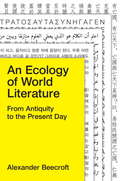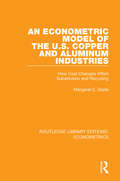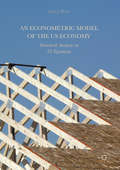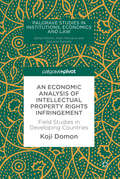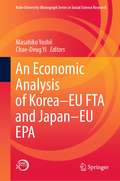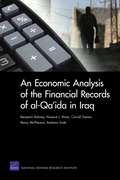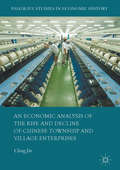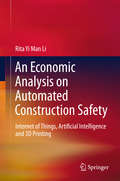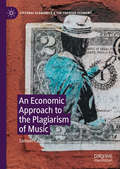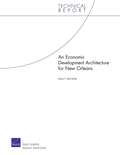- Table View
- List View
An Ecology of Knowledges: Fear, Love, and Technoscience in Guatemalan Forest Conservation (Experimental Futures)
by Micha RahderGuatemala's Maya Biosphere Reserve (MBR), the largest protected area in Central America, is characterized by rampant violence, social and ethnic inequality, and rapid deforestation. Faced with these threats, local residents, conservationists, scientists, and NGOs in the region work within what Micha Rahder calls “an ecology of knowledges,” in which interventions on the MBR landscape are tied to differing and sometimes competing forms of knowing. In this book, Rahder examines how technoscience, endemic violence, and an embodied love of wild species and places shape conservation practices in Guatemala. Rahder highlights how different forms of environmental knowledge emerge from encounters and relations between humans and nonhumans, institutions and local actors, and how situated ways of knowing impact conservation practices and natural places, often in unexpected and unintended ways. In so doing, she opens up new ways of thinking about the complexities of environmental knowledge and conservation in the context of instability, inequality, and violence around the world.
An Ecology of World Literature
by Alexander BeecroftWhat constitutes a nation's literature? How do literatures of different countries interact with one another? In this groundbreaking study, Alexander Beecroft develops a new way of thinking about world literature. Drawing on a series of examples and case studies, the book ranges from ancient epic to the contemporary fiction of Roberto Bolaño and Amitav Ghosh. Moving across literary ecologies of varying sizes, from small societies to the planet as a whole, the environments in which literary texts are produced and circulated, An Ecology of World Literature places in dialogue scholarly perspectives on ancient and modern, western and non-western texts, navigating literary study into new and uncharted territory.From the Trade Paperback edition.
An Econometric Analysis of Countries' Repayment Performance to the International Monetary Fund
by Rupert Thorne Lynn AylwardA report from the International Monetary Fund.
An Econometric Analysis of the Determinants of Inflation in Turkey
by Laura Papi Cheng Hoon LimA report from the International Monetary Fund.
An Econometric Model of the U.S. Copper and Aluminum Industries: How Cost Changes Affect Substitution and Recycling (Routledge Library Editions: Econometrics #17)
by Margaret E. SladeOriginally published in 1984. This book addresses the economics of the changing mineral industry, which is highly affected by energy economics. The study estimates, in quantitative terms, the short- to mid-term consequences of rising energy prices alongside falling ore quality for the copper and aluminum industries. The effects of changing cost factors on substitution between metals is assessed as is the potential for relying on increased recycling. Copper and aluminum industry problems should be representative of those faced by the mineral processing sector as a whole. Two complex econometric models presented here produce forecasts for the industries and the book discusses and reviews other econometric commodity models.
An Econometric Model of the US Economy: Structural Analysis in 56 Equations
by John J. HeimThis book explores the US economy from 1960 to 2010 using a more Keynsian, Cowles model approach, which the author argues has substantial advantages over the vector autoregression (VAR) and dynamic stochastic general equilibrium (DSGE) models used almost exclusively today. Heim presents a robust argument in favor of the Cowles model as an answer to the pressing, unresolved methodological question of how to accurately model the macroeconomy so that policymakers can reliably use these models to assist their decision making. Thirty-eight behavioral equations, describing determinants of variables such as consumption, taxes, and government spending, are connected by eighteen identities to construct a comprehensive model of the real US economy that Heim then tests across four different time periods to ensure that results are consistent. This comprehensive demonstration of the value of a long-ignored model provides overwhelming evidence that the more Keynesian (Cowles) structural models outperform VAR and DSGE, and therefore should be the models of choice in future macroeconomic studies.
An Economic Analysis of Conflicts: With an Application to the Greek Civil War 1946-1949
by Nicos ChristodoulakisThis book provides a quantitative framework for the analysis of conflict dynamics and for estimating the economic costs associated with civil wars. The author develops modified Lotka-Volterra equations to model conflict dynamics, to yield realistic representations of battle processes, and to allow us to assess prolonged conflict traps. The economic costs of civil wars are evaluated with the help of two alternative methods: Firstly, the author employs a production function to determine how the destruction of human and physical capital stocks undermines economic growth in the medium term. Secondly, he develops a synthetic control approach, where the cost is obtained as the divergence of actual economic activity from a hypothetical path in the absence of civil war. The difference between the two approaches gives an indication of the adverse externalities impinging upon the economy in the form of institutional destruction. By using detailed time-series regarding battle casualties, local socio-economic indicators, and capital stock destruction during the Greek Civil War (1946-1949), a full-scale application of the above framework is presented and discussed.
An Economic Analysis of Income Tax Reforms (Routledge Revivals)
by G.C Ruggeri Carole VincentFirst published in 1998, Ruggeri and Vincent analyse different tax reform proposals to create a discourse on dispelling the myths surrounding the flat tax. This book proposes a progressive and comprehensive tax reforms, whilst simplifying the tax system for the vast majority of tax payers. Whilst ensuring the tax system reforms dose not hinder economic growth. This book should be required reading for anyone interested in the problems and promise of tax reform.
An Economic Analysis of Intellectual Property Rights Infringement: Field Studies in Developing Countries (Palgrave Studies in Institutions, Economics and Law)
by Koji DomonUsing unique field research from across Asia, this book examines the real markets of illicit products that breach intellectual property rights (IPR). The text presents three case studies regarding IPR infringements: unauthorised music content; fake spare parts of motorcycles; and fake Japanese food. Each study has unique characteristics, though their general concepts and problems have similar roots. The book shows what is happening in the black market and systems of illicit trade, providing information for stakeholders in Intellectual Property Rights to consider in devising effective methods for minimizing profits lost to copied and fake products.
An Economic Analysis of Korea–EU FTA and Japan–EU EPA (Kobe University Monograph Series in Social Science Research)
by Masahiko Yoshii Chae-Deug YiThis monograph compares two trade agreements among three important economic regions, namely, the Korea–EU free trade agree (FTA) and the Japan–EU Economic Partnership Agreement (EPA). The two new types of agreements came into effect in the 2010s. They not only create more favorable trade and economic conditions in these regions but also produce spillover effects to bring about more comprehensive conditions in other area. First, the quantitative research for both agreements using the CGE model and a tentative analysis of the Japan–EU EPA in the analysis show that both have already created positive impacts on all three economies by lifting or reducing tariff and non-tariff barriers. Such positive impacts are also expected to be felt by SMEs in these countries that are involved. Additionally, the high level of tariff and non-tariff liberalization in the two current agreements will make positive impacts on the negotiation of other FTAs and on WTO reform. The advantages of the FTA and EPA dealt with in this book are not restricted to these economic effects. As the agreements are comprehensive, they will create more favorable social conditions not only in these economic regions but in other areas of Asia as well.
An Economic Analysis of the Financial Records of al-Qa'ida in Iraq
by Benjamin Bahney Carroll Ganier Barbara Sude Renny Mcpherson Howard J. ShatzThis monograph analyzes the finances of the militant group al-Qa'ida in Iraq in Anbar province during 2005 and 2006, at the peak of the group's power and influence. The authors draw on captured financial documents that give details on the daily financial transactions of one specific sector within Anbar province and of the financial transactions of the AQI provincial administration.
An Economic Analysis of the Rise and Decline of Chinese Township and Village Enterprises (Palgrave Studies in Economic History)
by Cheng JinThis book provides a historical economic analysis of two key issues relating to township and village enterprise (TVE) development in China. Firstly, the nature of the evolving relationship between TVEs and local government; in particular how TVE entrepreneurs have used institutionalized power to secure the political influence needed to defend their financial independence. Secondly, the relationship between TVEs and state-owned enterprises (SOEs), and the role of SOEs in China's economic transition. This study highlights the importance of the role of SOEs in the "dual-track pricing system" and its impact on other parts of the economy. Township and village enterprises were key to China's success in the late twentieth century, but have more or less disappeared as an entity over the past decade or so. By measuring the structural difference of the SOE sector before and after 1998-2003 SOE reform, Jin explains their fast catch-up in productivity since the mid-1990s, as well as the relative decline of TVE productivity.
An Economic Analysis on Automated Construction Safety
by Rita Yi LiThis book addresses information technologies recently applied in the field of construction safety. Combining case studies, literature reviews and interviews to study the issue, it presents cutting-edge applications of various information technologies (ITs) in construction in different parts of the world, together with a wealth of figures, tables and examples. Though primarily intended for researchers and experts in the field, the book will also benefit graduate students.
An Economic Approach to the Plagiarism of Music (Cultural Economics & the Creative Economy)
by Samuel CameronThis book is an economic analysis of plagiarism in music, focusing on social efficiency and questions of inequity in the revenue of authors/artists. The organisation into central chapters on the traditional literary aspect of composition and the technocratic problem of ‘sampling’ will help clarify disputes about social efficiency and equity. It will also be extremely helpful as an expository method where the text is used in courses on the music business.These issues have been explored to a great extent in other areas of musical content—notably piracy, copying and streaming. Therefore it is extremely helpful to exclude consumer use of musical content from the discussion to focus solely on the production side. This book also looks at the policy options in terms of the welfare economics of policy analysis.
An Economic Development Architecture for New Orleans
by Kevin F. MccarthyIn response to the current situation in New Orleans in the aftermath of Hurricane Katrina, this report provides recommendations regarding effective organizational and strategic approaches to revitalizing the city's economy, identifies the best practices that other cities have used to foster economic development, describes how these practices might be applied to New Orleans, and considers historical trends and past development missteps.
An Economic Geography of Oil (Routledge Revivals)
by Peter R. OdellAn Economic Geography of Oil, first published in 1963, analyses the reasons behind the spatial distribution of the different sectors of the world oil industry. In the first part of the book, Peter Odell examines the pattern of the world supply of oil, showing the important changes that took place between 1945 and the early 1960s and highlighting the physical, economic, political and organizational factors which contributed to these developments. In the second part, Odell analyses the relationship between oil and other sources of energy, together with the more fundamental relationship between energy consumption in different areas of the world, and economic development. Finally, attention is paid to those aspects of the industry which are concerned with getting the oil from the point of production to that of consumption; the refining industry, transportation requirements and local distribution patterns are studied. These strands are drawn together in a relevant and interesting conclusion, which considers the overall impact of the oil industry on economic and industrial development.
An Economic Historiography of Germany, 1918-1931: How Inflation and Foreign Capital Inflows Allowed the Weimar Republic to Survive (Frontiers in Economic History)
by Elena Seghezza Giovanni B. PittalugaContrary to existing economic analyses of the Weimar Republic, this book looks beyond the explanations of the individual events that characterized it - in particular hyperinflation, Brüning's fiscal policy, and the 1931 crisis. Instead, it adopts a more unified approach, and thereby sheds light on the underlying causes of these events. The book argues that these individual events were the final result of economic processes and policy choices which had made it possible to mitigate the social and political conflict that would otherwise have undermined the Republic’s existence. Specifically, it postulates that hyperinflation was the result of the "persistent" inflation, which had permitted Germany to maintain low unemployment, meet unions' wage demands, and contain left-wing radicalism. Similarly, the banking and currency crisis of 1931 was caused by a sudden stop related to the high level of foreign debt incurred by Germany after the Dawes Plan. Debt which had, however, enabled the country to finance the persistent external deficits resulting from its high domestic demand and large public expenditure incurred in an attempt to avoid social conflict. The book reviews the various models and approaches proposed highlighting their relative strengths and weakness and concludes by providing a unifying common thread which explains how the dramatic economic events which characterized the Weimar Republic were the result of the very economic processes which had contributed to its temporary survival. This book will appeal to students, scholars, economic researchers in general, and more specifically to those interested in economic history, monetary and financial economics, economic policy, political decision making, and political economy, in particular, those seeking a better understanding of the Weimar Republic's economic history.
An Economic History of Modern France (Routledge Revivals)
by Francois CaronFirst published in 1979, this richly documented study of French development from the early nineteenth century to the present day is of particular importance to students both of history and economics. Francis Caron moves as confidently through the fields of current economic policy and modern economics as he does through the traditional subject matter of French nineteenth-century economic history. His book incorporates the mass of research that has appeared in monograph and periodical form in recent years, making it accessible for the first time to the English-speaking reader.
An Economic History of British Steam Engines, 1774-1870: A Study on Technological Diffusion (Contributions to Economics)
by Haris KitsikopoulosThis book traces the diffusion trajectory of the second and third generation of British steam engines, the Watt and high-pressure models, covering the period 1774 to 1870. It begins by subjecting to econometric analysis the latest version of Dr. Kanefsky's database on 18th century steam engines coming up with an upward revision of the total amount of horsepower installed by 1800. Subsequent chapters delve into the determinants of the diffusion process through the third quarter of the 19th century relating to engines used both in mining and industry as well as transportation (railways, steam cars). The book's main contribution to the literature lies in drawing material from a very large volume of 18th- and 19th-century sources found in the Dibner Library of Rare Books, Smithsonian, and by utilizing a fair amount of technical literature pertaining to the economic factors driving the diffusion process. This great expansion of the empirical material has led to bringing multiple revisions to the work of other authors on the key aspects and determinants of the diffusion process. In conjunction with the publication by the author of an earlier monograph on the first generation of steam engines, the Newcomen model, the present study completes the task of offering the most comprehensive account of the preeminent and most strategic technology of the British Industrial Revolution. This book will appeal to students, scholars, and researchers of economic history and history of technology, interested in a better understanding of the industrial revolution in general and the role of British steam engines in particular.
An Economic History of Development in sub-Saharan Africa: Economic Transformations and Political Changes (Palgrave Studies in Economic History)
by Ellen Hillbom Erik Green‘This is a desperately needed book. It not only surveys the field of African economic history at the level of undergraduate students, but provides several fresh perspectives, drawing on insights from the latest research on the evolution of African societies and their economic prosperity. This valuable source of teaching material will be the premier text on African economic history for at least the next decade.’—Johan Fourie, Stellenbosch University, South Africa This upper level textbook offers a historical understanding of sub-Saharan Africa. By looking at the economic history of the African region from before the arrival of European territorial control all the way through to Africa’s integration in the current era of globalisation, readers can understand the development paths for African countries today. Organisation of production, social structures, trade, and governance are key factors in the discussion about African success stories and failures. Suitable reading for upper level undergraduates, MSc and postgraduate students, in addition to policy makers and development practitioners looking for a comprehensive overview of Africa from an economic and social perspective. Hillbom and Green also provide a starting point for the study of African economic history for those who would like to continue their own research in this area.
An Economic History of Early Modern India
by Tirthankar RoyThe death of the Mughal emperor Aurangzeb in 1707 until the annexation of Maratha territories by the British East India Company in 1818 was a period of transition for the economy of India. This book focuses on these transitions, and shows how a study of this period of Indian history contributes to a deeper understanding of the long-run patterns of economic change in India. Momentous changes occurred in business and politics in India during the eighteenth century - the expansion of trade with Europe and the collapse of the Mughal Empire, resulting in the formation of a number of independent states. This book analyses how these two forces were interrelated, and how they went on to change livelihoods and material wellbeing in the region. Using detailed studies of markets, institutions, rural and urban livelihoods, and the standard of living, it develops a new perspective on the history of eighteenth century India, one that places business at the centre, rather than the transition to colonial rule. This book is the first systematic account of the economic history of early modern India, and an essential reference for students and scholars of Economics and South Asian History.
An Economic History of England 1870-1939
by William AshworthThis is a comprehensive account of a decisive epoch in England's economic development by a leading economic historian. 'Works of economic history often get bogged dwon in figures - so many machines, so much unemployment, often, too, they are histories of technology, not of economic organization. Professor Ashworth goes to the opposite extreme in a most praiseworthy way: his book is actually good to read. Though there are tables of statistics (eleven of them), the book is an essay in interpretation, not an encyclopedia; it enriches our understanding rather than adding to our knowledge.' A.J.P. Taylor. This classic book was first published in 1960.
An Economic History of England: The Eighteenth Century
by T.S. AshtonT.S. Ashton has sought less to cover the field of economic history in detail than to offer a commentary, with a stress on trends of development rather than on forms of organization or economic legislation. This book seeks to interpret the growth of population, agriculture, maufacture, trade and finance in eighteenth-century England. It throws light on economic fluctuations and on the changing conditions of the wage-earners. The approach is that of an economist and use is made of hitherto neglected statistics. But treatment and language are simple. The book is intended not only for the specialist but also for others who turn to the past for its own sake or for understanding the present. This book was first published in 1955.
An Economic History of Europe
by Antonio Di VittorioAn Economic History of Europe provides students with a comprehensive introduction to European economic history from the fifteenth century to the present day. Individual chapters offer brief references to previous historical periods and events, with special attention given to core themes concerning economic development, and an analysis of their change through time and space. Core themes examined in each period include: the increasing prominence of industry international trade demand and supply dynamics agriculture. The unique structure of this text enables students not only to gain a firm grounding in the long-term evolution of the European economy, but also provides an historical overview of the economic development of individual countries. Individual contributors analyze the shift from the modern to the contemporary period and offer a broad explanation of the historical roots of the problems that face today's economic development. This key text is indispensable reading for students in economics, economic history, development economics and history.
An Economic History of Europe
by Karl Gunnar PerssonThis concise introduction is the only textbook students will need to understand Europe's unique economic development and its global context.

